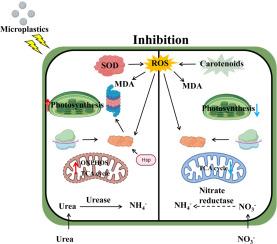Transcriptomic analysis of dinoflagellate Prorocentrum cordatum exposed to microplastics under different nitrogen sources
IF 4.5
1区 生物学
Q1 MARINE & FRESHWATER BIOLOGY
引用次数: 0
Abstract
Anthropogenic activities have significantly altered marine nitrogen (N) regimes by releasing different forms of N (e.g. nitrate and urea, the latter from wastewater/agricultural runoff). Some species can grow equally well under different N sources, while others show maximum growth rates under one source (e.g. urea). Another pollutant, plastic microparticles (MP), has been found in every ecosystem/habitat on Earth. A crucial deleterious effect of MP is the disruption of the cellular membrane integrity—a key mechanism affecting the N uptake and assimilation in single-cell organisms such as dinoflagellates and microalgae. The combined effects of MP and different N sources remain an open question. This study exposed the dinoflagellate Prorocentrum cordatum to microplastics (MP, concentrations of 0 or 10 mg L−1) with urea (U) or nitrate as nitrogen sources, both at 440 µmol L−1 during 16 d to investigate the response of P. cordatum in terms of physiology and nitrogen metabolism. P. cordatum showed a similar growth rate, pigment contents (chlorophyll a and carotenoids), lipid peroxidation (MDA), nitrate reductase, and nitrogen consumption rate (CN) in both N sources. The addition of MP under both nitrogen sources decreased growth but increased pigments, SOD and Urease activity, and MDA level, significanlty. The CN was reduced by ∼50 % in the Microplastics + nitrate treatment (MPN), whereas it remained unchanged in the Microplastics + Urea treatment (MPU). At the transcriptomic level, the MP addition resulted in an approximate 2.5-fold increase in the number of differentially expressed genes (1811) under MPU compared to MPN (731). The MPU significantly upregulated pathways involving nitrogen assimilation and metabolism, endocytosis and phagosome, and further electron transport in photosynthesis and energy metabolism, but MPN downregulated those pathways. This suggests higher cellular metabolism under MPU compared to MPN. Additionally, cells in MPU upregulated pathways of antioxidation, heat shock protein, ubiquitin-mediated proteolysis, and proteasome in response to MP-induced stress, whereas the variations of these pathways in MPN were limited. These results shed light on the combined effects of urea as a source of nitrogen and MP exposure, providing insight into the metabolic flexibility of P. cordatum under future environmental stress.

不同氮源下暴露于微塑料的双鞭毛藻原心的转录组学分析
人为活动通过释放不同形式的氮(如硝酸盐和尿素,后者来自废水/农业径流),显著改变了海洋氮(N)制度。有些物种在不同氮源下生长同样良好,而另一些物种在一个氮源(如尿素)下生长速度最大。另一种污染物,塑料微粒(MP),在地球上的每个生态系统/栖息地都被发现。MP的一个关键有害影响是破坏细胞膜完整性,这是影响单细胞生物(如鞭毛藻和微藻)氮吸收和同化的关键机制。MP和不同氮源的综合效应仍然是一个悬而未决的问题。本研究以尿素(U)或硝酸盐为氮源,将双鞭毛藻cordatum暴露于浓度为0或10 mg L−1的微塑料(MP)中,浓度均为440 μ mol L−1,持续16 d,研究cordatum在生理和氮代谢方面的反应。在两个氮源下,桃草的生长速度、色素含量(叶绿素a和类胡萝卜素)、脂质过氧化(MDA)、硝酸盐还原酶和氮耗率(CN)相似。在两种氮源下,MP的添加均显著降低了幼苗的生长,但显著提高了色素、SOD和脲酶活性以及MDA水平。在微塑料+硝酸盐处理(MPN)中,CN降低了约50%,而在微塑料+尿素处理(MPU)中则保持不变。在转录组学水平上,MP的添加导致MPU下差异表达基因的数量(1811)比MPN(731)增加了大约2.5倍。MPU显著上调氮同化和代谢、内吞和吞噬体以及光合作用和能量代谢中的电子传递等途径,而MPN则下调这些途径。这表明与MPN相比,MPU下的细胞代谢更高。此外,MPU中的细胞在mp诱导的应激下上调抗氧化、热休克蛋白、泛素介导的蛋白水解和蛋白酶体通路,而MPN中这些通路的变化有限。这些结果揭示了尿素作为氮源和MP暴露的综合效应,为未来环境胁迫下柱头草的代谢灵活性提供了见解。
本文章由计算机程序翻译,如有差异,请以英文原文为准。
求助全文
约1分钟内获得全文
求助全文
来源期刊

Harmful Algae
生物-海洋与淡水生物学
CiteScore
12.50
自引率
15.20%
发文量
122
审稿时长
7.5 months
期刊介绍:
This journal provides a forum to promote knowledge of harmful microalgae and macroalgae, including cyanobacteria, as well as monitoring, management and control of these organisms.
 求助内容:
求助内容: 应助结果提醒方式:
应助结果提醒方式:


